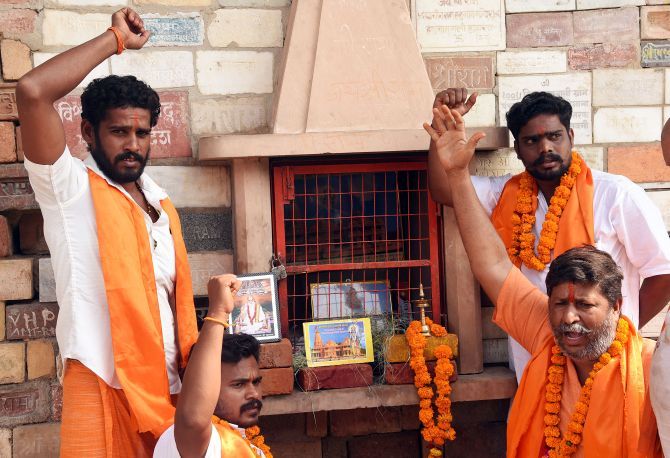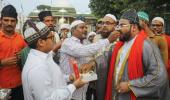'If the Ram Mandir is made, it is because of the collective strength of our country.'

Bhupender Yadav is emerging as the man for all seasons in the Bharatiya Janata Party.
Under Narendra Damodardas Modi's leadership, in its second term in power, the BJP is going to see many fundamental changes. Modi is trying to make the BJP fit for the 21st century.
Yadav is one of the most trusted members of the team handling the assignment of transformation .
In the last six years he has headed 12 Parliamentary committees which in itself speaks about his position in Modi's scheme of things.
His strengths are that he is a lawyer and participated early in the party's major agenda including the Ayodhya movement.
He was the government council before the Liberhan Commission which inquired into the December 6, 1992 demolition of the Babri Masjid.
Yadav explains what the August 5 bhoomi puja of the Ram Mandir means to him and his party. The first part of an exclusive interview with Senior Rediff.com Contributor Sheela Bhatt.
How do you see the bhoomi puja of the Ram Mandir on August 5?
The issue of the Ram Janambhoomi is the issue portraying a cultural renaissance of the country.
We should not look at this event narrowly.
Bhagwan Ram has been India's hero. Ram was a very compassionate and modest ruler.
Ram fought against injustice. Shri Ram was also the kind of ruler who articulated people's welfare at the centrepoint of governance.
And Ram is -- from every category, every understanding, and, for everybody in India's traditions -- a spiritual being.
And we believe that despite the disagreements in our society, we have our private lives as well, where we have our own relationships, subjects, liabilities, responsibilities and duties.
Lord Ram is present not just in India, but he is present in the history of all of South East Asia, be it Sri Lanka or Thailand, be it Cambodia or Laos, every place has a performance of the Ramayan and Ram Leela.
Ram is for mankind. And, when I call making of the Ram temple a cultural renaissance, this culture has been around for a long time.
It is a part of our ethics, lifestyle and values.
And that continuity was hurt by the people who subjected India to slavery.
People have struggled for long to reclaim that space in public. Later, we fought a legal battle against British from 1863 onwards.
Ultimately the Supreme Court finalised the issue of our faith and our rights.
After the judgment, the government created a sense of peace across the country.
According to the orders of the Supreme Court, a trust was made.
And that long time wish of the Indian people that the place that was the birthplace of such a great ruler becomes a place of social welfare, equality, trust, traditions, development and harmony across every category, where welfare of the world is practiced, the opportunity for that to be created has been presented on August 5.

Quite a few leaders of the Muslim community fought this issue for over fifty years in the Supreme Court, so this is not a small issue.
There is no anger, because after the judgment arrived not a single stand was taken against it.
Moreover, the land that was allotted to the Muslims, they have accepted it.
Now there is no controversy over this.
Ram is not only for the Hindus, Ram is for everyone. Everyone includes Hindus and Muslims. There is no controversy.
But there is controversy regarding demolition of the Babri Masjid. Without the demolition there was no possibility of a temple. Right?
This is no longer a topic of controversy. The decision has been made.
I know what every Indian feels, every Indian -- be it young, old, poor, rich, upper class, lower class, across different religions. Everyone is happy with the decision.

Is India united on this issue?
I feel so. And I am completely confident also. You can see it. All stakeholders are functioning peacefully.
When L K Advani lead the Ram Mandir movement it had political considerations.
For a long time, in our country, in an unfortunate manner, politics is seen through a narrow prism.
There was a point in time when the BJP started speaking against pseudo-secularism.
The proposal was passed at (the BJP's) Palampur session (national convention i 1989) also.
For the cultural restoration of original India, there should be a Ram Mandir made on the Ram Janambhoomi, this was also presented in the agenda by the BJP.
And there is nothing wrong, because any political party has an objective to contribute to the pride of the country.
And the main principle of the BJP is that India comes First.
The BJP has come forward with an ideological mission.
In 1952, when the BJP only got three percent votes, we had the ideology which is the same now in 2020, when we have got 303 seats.
We have been awakening people towards our views as we have been moving forward.

Behind Advani's movement there was political consideration too.
That had our commitment.
Whoever wants to look at it politically can do so, but yes, the commitment is to take India forward keeping its glorious traditions intact and making India a great country.
Our core cultural heritage, scientific approach and Indian Constitutional values, these three things are what makes up our ideology.
I would repeat these hundred times!

Who all should be credited for the movement?
There was a collective community leadership since 1526, the start of Babur's rule.
Whenever and wherever in India there was an attack on religion places people constantly fought, protested and struggled for the dignity of the place.
In this context, the Rath Yatra and Advaniji has played an important part.
Particularly, Advaniji spread awareness of the issue all over India.
But several people who were not politically inclined, from Ashok Singhalji, Ramchandra Paramhansji to many swamis to Rajmata Vijayarajeji (Scindia) and at one point even the Congress's Nirmal Khatriji played a role.
People who went to remove the locks, to people who worshipped Ram over centuries have contributed and played a role in awakening of consciousness of Ram.
From 1526 to 2020, hundreds of millions of faithful Indians have kept the issue alive.
The culture of the Ramayan, the life of Ram, every year those who perform the Ram Leela, in every language in India, in every village, in every city have helped in the endeavour.
Ram has been kept alive in our hearts.
And if the Ram Mandir is made, it is because of the collective strength of our country.
- Part 2: 'Gandhi's Ram is my Ram'
Feature Presentation: Aslam Hunani/Rediff.com










